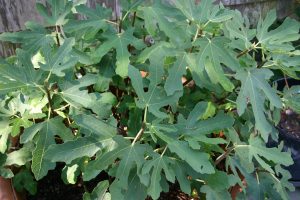I really enjoy fresh figs, but here in New England they can be difficult to grow because of the long, cold winters. To combat the deep-freeze time of year, New Englanders often dig their fig trees up each fall, wrap them in burlap, and bury them in a trench covered with mulch for the winter. Or they grow the trees in pots and move them into the garage or basement during the coldest months.

Another alternative is available to northerners with a greenhouse. The Peter’s Honey fig tree I planted in the ground of my heated greenhouse rewarded me with over 100 pounds of fruit each year. But ultimately it grew so tall that it threatened to lift off the ceiling, so I had to remove it. In retrospect, I could have planted it outdoors in the summer and done the burlap-wrapping and burial routine for winter, but instead I cut it back and propagated some smaller trees from it. I also have a Celeste fig tree that’s done well in my heated greenhouse, and I recently purchased a White Marseille, which is a hardy variety that’s said to be one of Thomas Jefferson’s favorites.
A few years ago I decided that New England winters were getting milder enough that I could experiment with leaving some fig trees in my unheated greenhouse for the winter. That worked well for three years in a row, but last winter an extreme cold spell in February killed off the tops of every one, causing me to fear that I had lost them all. But I fertilized them anyway, and about six weeks later they began to develop new sprouts. Now I have a bumper crop of figs coming on new wood. Needless to say, I’m quite pleased.
This winter I’m going to try something different with one of my Brown Turkey fig trees by planting it outdoors on the south side of my unheated greenhouse. I’ve been told that fig trees of this variety grown at Green Animals Topiary Garden in Portsmouth, RI, have wintered over in sunny, outdoor locations for the last five or six years without any burlap-wrapping, heavy mulching, or other elaborate protections. And these trees have produced bumper crops of figs annually. This seems like a worthwhile experiment to try, which I’ll report on next summer. In the meantime, I’m going to enjoy a fresh fig from my greenhouse!










